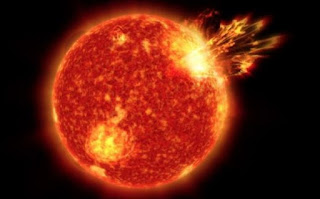Space experts Track down a Close by Star That a Carbon copy of a Youthful Sun Organization logo
Our Sun is about 4.6 billion years of age. We realize that from models of Sun-like stars, just as through our perceptions of different stars of comparative mass. We realize that the Sun has developed more sultry after some time, and we realize that in around 5 billion years it will end up being a red monster star prior to taking its life as a white midget. Yet, there are numerous things about the Sun's set of experiences that we don't comprehend. How dynamic was it in its childhood? What properties of the youthful Sun permitted life to shape on Earth billions of years prior?
Representation of what the Sun might have been similar to 4 billion years prior, around the time life created on Earth. Credit: NASA's Goddard Space Flight Center/Calculated Picture Lab. Public Space Picture.
On the off chance that we had a time machine, we could make a trip to the far off past and notice the Sun's childhood straightforwardly. In any case, since that is unrealistic, we can do the following best thing. Search for youthful stars that are practically the same in size and organization to our Sun. A carbon copy of the Sun, maybe. This has been done before with more seasoned stars. HIP 102152, for instance, is a sun based doppelganger that is around 4 billion years more seasoned than our Sun. Presently a group has examined a youthful sunlight based doppelganger known as kappa-1 Ceti.
A craftsman idea of a coronal mass discharge hitting youthful Earth's frail magnetosphere. Credit: NASA/GSFC/CIL
The star has been concentrated since the 1940s. It's basically the same as the Sun in mass and metallicity, however it's just around 600 million years of age. For this examination, the group incorporated observational information of kappa-1 Ceti with developmental sun based models. From this, they could make forecasts about how the Sun acted at a comparable age. In view of their model, the Sun likely pivoted around multiple times quicker than it does now, had a lot more grounded attractive field, and produced more sun based flares and high-energy particles.
This fascinating thing about the Sun at around 600 million years of age is that life on Earth previously showed up around this time. Understanding the Sun at this age could give us pieces of information about how earthbound life shaped. This investigation holds some tempting prospects. Since the World's attractive field was more fragile in those days, sun based flares and coronal mass discharges from the youthful Sun would have presented Earth to more high-energy particles than they do today. These particles might have assisted complex atoms with shaping on Earth. In case that is the situation, a functioning youthful Sun might play had a vital influence in framing the structure squares of life.
This is an underlying examination, so the association with life is dubious. Yet, the group desires to accumulate information from other Sun-like stars at different ages. With more perceptions, they will actually want to adjust their model and make a more exact history of the Sun.

Comments